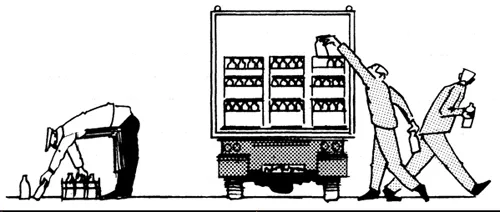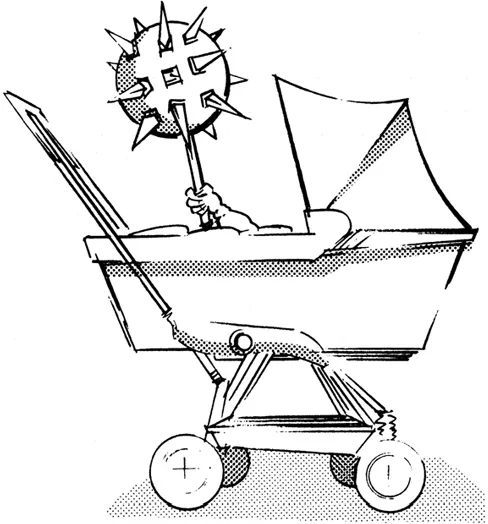1
Design and crime
In recent years many of the household surveys undertaken to gauge national and local opinions on social issues and the quality of life have identified ‘crime’ as one of the major concerns. Glasgow University’s recent quality of life study (Rogers et al., 1989) found that ‘low levels of crime’ was the most desirable environmental factor perceived by the general public. The Second Islington Crime Survey (Middlesex Polytechnic, 1990) found that in the three years since the first survey, crime had moved from third place to the top of the list of problems identified as affecting the neighbourhood. It was cited by 80.5% of people, compared with 71% in 1986.
The links between levels of crime and housing design have also been the subject of much discussion and research. When looking for simplistic answers to crime and social problems it has been easy to blame design without considering other f actors such as the style of housing management, the mix of tenancies, local levels of unemployment and available social amenities. As yet there is no conclusive evidence to prove that design is the major factor in creating or solving problems of law and order. Design, on its own, does not cause crime or cause people to become criminals; however, some design features do appear to exacerbate local crime problems, although the same features in a different situation may not have the same effect.
1.1 FACTS ABOUT CRIME
Although crime, or the fear of crime, can have a dramatic and devastating effect on peoples’ every day lives, the public often have an exaggerated and inaccurate perception of the true nature and level of crime. Architects, planners and housing managers must work together with residents and local communities to develop an accurate picture of what is happening and to try and identify why problems exist, before they can formulate solutions.
Before 1980 most of our information about crime came from official crime statistics, which included only those crimes reported to and recorded by the police. However, in recent years local and national crime surveys have greatly increased the amount of information available. Taken together, these surveys have shown that crime is more widespread than records previously showed: more than twice as much burglary, five times as many woundings and ten times as much vandalism.
However, the chances of being a victim remain slight. On average individuals are likely to be a victim of robbery (thefts or attempted thefts involving threats or actual force) once in every 200 years, of theft from the person (without threats or actual force) once in every 100 years and of wounding once in every 70 years. Households are likely to experience burglary (with loss) only once every 37 years, theft of vehicles once every 50 years, theft from motor vehicles once in every 9 years and vandalism once in every 6 years. Most crime is non-violent and involves property offences: most commonly thefts from motor vehicles, vandalism and burglary.
Much crime is carried out by young people and one half of all recorded crime is carried out by people under 21; nearly two-thirds of burglaries are carried out by people in this age group. The peak age for male convictions is 18 and for female convictions 15. Before their 28th birthday 30% of men have acquired a criminal conviction. Prior to 1988, the male peak was 15, but increasing use of police cautioning as opposed to charging has led to a reduction in juvenile convictions.
Crime is unevenly distributed across the country and throughout the population, being concentrated in inner urban areas and on large housing estates. Those that suffer most are the low-income households. On some high crime council estates, 1 in every 5 households is the victim of burglary each year, and a member of every 10 households is a victim of assault. Unskilled workers are twice as likely to be burgled as professional workers. Black people are more likely to be victims of crime than white and council tenants more than home owners. Young men are more likely to be victims of assault, although they tend to be the least fearful, while elderly people tend to be the most fearful and least likely to be victims. When sexual assault and domestic violence are taken into consideration, young women are more likely to be victims than young men. One quarter of reported violent crime involves domestic violence against women, and women and children are more likely to be attacked by someone they know in their home than by a stranger in the street.
Most crime is non-violent.
Despite this picture of crime as an urban problem, the crime rate in certain parts of the suburbs has been rising at equal or even greater rates than in the city. Surveys show that there is considerable justification for focusing attention on inner city and outer urban estates, particularly in the most deprived areas. Yet it would be wrong to suppose that crime is a feature of only these areas or that crime in suburban areas or towns is insignificant.
1.2 FEAR OF CRIME
It is not only crime which is a problem, the fear of crime can be almost as serious in its consequences. Such fear cannot be dismissed solely as the result of media distortion of unreliable crime statistics and a focus on violent, but rare, crimes. For many people fear of crime is at least partly dependent on their own experience, such as witnessing acts of vandalism or knowing someone who has been a victim. For some, fear of crime also reflects the greater likelihood of becoming a victim. Women are generally more fearful of crime and also suffer more from certain types of crime, such as sexual assault, domestic violence and street robbery. Not surprisingly where crime rates are highest, people are more fearful. In many inner city areas, and on some outer council estates, significant numbers of people (women, elderly people and some ethnic groups in particular) are living in a state of considerable anxiety. Fear of crime causes those who can to move away from what are seen as crime prone areas and those who cannot to retreat into their homes. As a result, the control which the community itself can exert over antisocial or petty criminal behaviour is reduced.
The Second Islington Crime Survey rejects the argument that the fear of crime greatly exaggerates the real risks. It argues that the high levels of fear experienced by women are entirely rational. The survey found that 74% of women, as opposed to 40% of men, stay in fairly or very often. Not going out is cited as only the most extreme result of the fear of crime, other behaviour includes avoiding certain streets, people and public transport, or always having a male companion. The survey concludes that 26% of women aged 16–24, 27% of those aged 25–54 and 68% of those aged over 55 never go out alone at night.
Despite being much less at risk than other groups the fear of crime is particularly prevalent amongst the elderly. It is not clear whether this is because they do not understand their risks or because the consequences of victimization may generally be more severe for them. They are more likely to be injured, upset or seriously inconvenienced by crime than younger people (Clarke et al., 1985). Whatever the reasons it is often stressed that, particularly for older people, the fear of crime is often more of a problem than crime itself. This fear can lead to self imposed ‘house arrest’ which is ironic as the evidence from recent research illustrates the vulnerability of elderly people in their own homes (Jones, 1987).
The research by Clarke identified three social determinants of fear of crime amongst elderly people. These were their perceptions of the crime rate, their degree of social isolation and the nature of their immediate environment. Jones adds a fourth, arguing that personal self-image is also an important factor affecting the fear of crime since it is a common belief that elderly people, being more vulnerable through both physical weakness and social isolation, make ideal victims. In addition, the majority of elderly people are women, therefore not just age but gender stereotypes contribute to this weak picture since women have had these feelings all their lives.
In such a vulnerable situation fear may well be an appropriate response and it is difficult to know how to lower this. Jones’ research indicated that when asked about the possible options for increasing the security of their environment most elderly people were in favour of community policing, that is, ensuring a visible police presence. Underwood (1984) suggested that a high police presence is unlikely to be effective as the young may view it as a challenge and it may even act as an encouragement to increase vandalism. Designing the built environment in order to minimalize the risk of crime is another option.
Most crime involves property offences.
Although fear often reflects vulnerability to crime, fear of assault and burglary have become a serious problem even in some rural areas and small towns where levels of crime are low. Such anxiety may be linked to reports of high urban crime rates that are thought to apply locally and to a disproportionate emphasis on violent and sexual offences and sensationalized reports of crime in local newspapers. The amount of crime that takes place should not be exaggerated, nor should the impact of crime on those most likely to be victims be understated. Experience or fear of crime is an everyday problem for many people. It needs to be dealt with by mobilizing the resources of local authorities, the community itself and the police.
Much crime is carried out by young people.
1.3 THE EFFECT OF DESIGN ON CRIME
It has been argued that there are three basic elements necessary for a person to commit a crime: ability, opportunity and motive. The provision of building security through design attempts is to eliminate or reduce the intruder’s ability and opportunity to commit a crime. This in turn should also reduce their motivation. Bennett and Wright (1984) explored some of the assumptions underlying situational crime prevention and deterrence theory by obtaining the views of the offenders themselves. Their study of burglars’ methods was based on information from burglars who had been caught. Although the validity of such responses is questionable, since these are failed burglars and successful ones might have different methods, their findings concurred with those of Jackson and Winchester (1982) from their study of both victims and non-victims of burglary in Kent.
Bennett and Wright found no clear connection between the physical environment and rates of burglary. However, they did identify surveillability and occupancy as the most important factors influencing burglars’ choice of targets; this concurs with Jackson and Winchester’s findings. Factors influencing the surveillability of the target included cover, presence and proximity of neighbours, whether the building was overlooked and if rear access existed. Risk cues relating to occupany included whether there was a car in the drive, a light on, or such evidence of occupancy as signs of a dog or a burglar alarm. Ease of access was affected by locks and the design of potential entry points.
The study found that most houses became the target for burglary for reasons independent of their degree of security. Targets were chosen partly because of the potential reward they may offer and because they were not occupied, but mostly because they could be easily approached without the burglar being seen. The importance of this concept of designing to deter and of natural surveillance is considered in greater detail in later chapters.
1.4 CRIME DISPLACEMENT
Bennett and Wright (1984) also indicated that casual burglars who seek targets are flexible and more likely to be displaced (i.e. will move onto another dwelling if prevented from entering the intended target), than offenders who planned one particular crime. The factors which were identified as exerting the greatest influence on displacement did not relate to ‘reward’ or ‘ease of entry’, but to ‘risk of getting caught’. The most important risk factors were identified as surveillability and occupany. Bennett and Wright note that these results were not new (this information had been previously available): they stress that the only surprise is that it has not been exploited in crime prevention programmes.
The danger of crime displacement is sometimes given as justification for not tackling the security problem of an estate. However, research by Allatt (1984) indicates that displacement need not necessarily be as great a problem as originally envisaged. Allatt used police statistics and a two stage tenant survey to consider the effect of target hardening techniques on the improvement of residential security in an entire ‘difficult to let’ estate. Both the effect upon the high burglary rate in the estate itself and the displacement of burglary to two adjacent neighbourhoods or into other property crimes on the estate were considered. In contrast with a control estate, where burglary rose, Allatt’s research indicated that burglary steadied for approximately one year and attempted burglary declined. Displacement effects were largely confined to the estate and overall crime was probably reduced.
1.5 TRADITIONAL APPROACHES TO CRIME PREVENTION
Until recently it was generally felt that responsibility for crime prevention lay with the police and individual householders. They alone, however, cannot solve the crime problem and deploying more police officers may have little or no effect on crime levels. Much police time is taken up in responding to crime after it has taken place, and the police do not have the resources or authority to...



